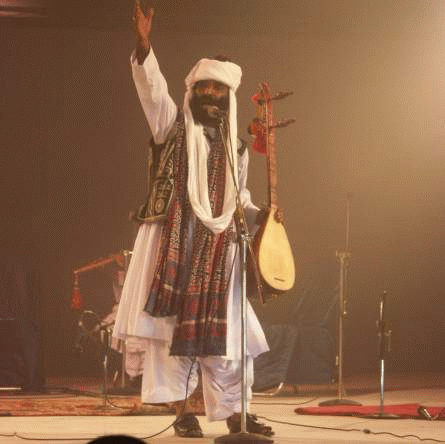
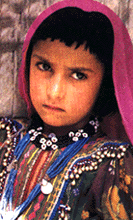
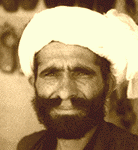

Balochistan - The Largest Land Mass Province



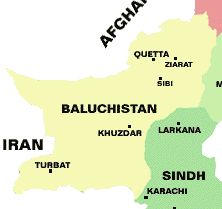 Balochistan
- rugged with endless landscape (devoid of vegetation) - is the largest province of Pakistan. Like
Punjab, it is also divided between Pakistan and Iran to the west. Besides Iran it neighbours Afghanistan and
Federally Administered Tribal Areas (FATA) to the north and
Punjab and Sindh to the east. To the south, its thirsty and perched dry vast
lands of Makran skirt the Arabian Sea. Although it is the largest in area, some 347,190 square kilometres, it has the smallest population. The low population density is attributed to scarcity of water.
Balochistan is located on a plateau in the west of Suleiman and
Khirthar mountain ranges. Chaghi mountains separate Balochistan with Afghanistan. Many mountain passes connect
Balochistan with Afghanistan, Bolan (below left) and Gomal passes being the noted ones. Balochistan traces its history as far back as 7000 BC when
Mehrgarh farming settlements existed in this part of Pakistan.
The atomic tests carried out by Pakistan in 1998 in the Chaghi mountains
(below right) brought Balochistan in limelight.
Quetta is the provincial metropolis
and is an important and thriving trade centre.
Balochistan
- rugged with endless landscape (devoid of vegetation) - is the largest province of Pakistan. Like
Punjab, it is also divided between Pakistan and Iran to the west. Besides Iran it neighbours Afghanistan and
Federally Administered Tribal Areas (FATA) to the north and
Punjab and Sindh to the east. To the south, its thirsty and perched dry vast
lands of Makran skirt the Arabian Sea. Although it is the largest in area, some 347,190 square kilometres, it has the smallest population. The low population density is attributed to scarcity of water.
Balochistan is located on a plateau in the west of Suleiman and
Khirthar mountain ranges. Chaghi mountains separate Balochistan with Afghanistan. Many mountain passes connect
Balochistan with Afghanistan, Bolan (below left) and Gomal passes being the noted ones. Balochistan traces its history as far back as 7000 BC when
Mehrgarh farming settlements existed in this part of Pakistan.
The atomic tests carried out by Pakistan in 1998 in the Chaghi mountains
(below right) brought Balochistan in limelight.
Quetta is the provincial metropolis
and is an important and thriving trade centre.

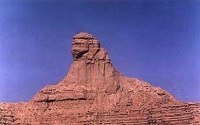
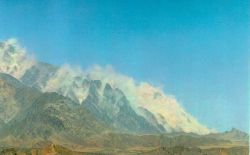
While Pakistan abounds in historical and natural features that attract the keen eyes of tourists the world over, an amazing feature was recently discovered (above centre), which resembles the Egyptian Sphinx on the coast of Makran along the Arabian Sea. Those visiting Balochistan and Makran Coast should not miss this great awe inspiring monument.
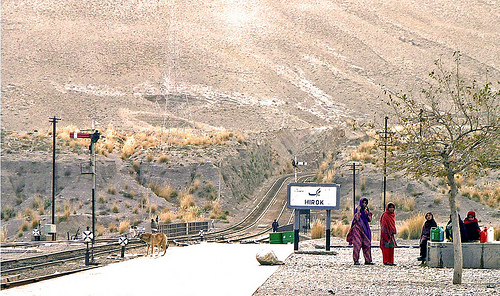
| Hirok station ,a remote place in Balochistan province is the only area around a hundred square kms ,where clean drinking water is available. These kids travel from their homes and cover almost 5 to 10 kms to reach here and fetch water in plastic cans and drums and carry a heavy load on their fragile shoulders. It is also noteworthy that the water source is not natural but only is supplied by trains from a relatively large station, nearby and filled in underground tanks. Sometime when the trains do not bring water it makes life more miserable for the people of the area and specially of these kids. Photo Courtesy: Commoner28th |
Balochistan has a population of around 7 million inhabitants. The Baloch numerically dominate the south of the province, while the Pashtuns are the majority in and around Quetta and the north. Near the Kalat region and other parts of the region the Brahui are a significant presence, while along the coast various Makrani peoples of mixed origins can be found such as the Meds and small groups of descendents of African slaves known as the Hupshi can also be found. Persian-speaking Dehwars also live in the Kalat region and further west towards the border with Iran. Some farmers from the adjacent Sind province have also settled in the arable lands in the east. Although a major portion of some 769,000 Afghan refugees has gone back to Afghanistan, their traces can still be felt in some areas.

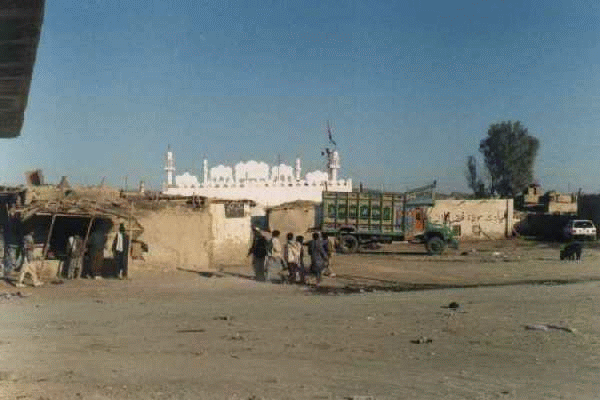
Above: Taftan Border Railway Station and Border Village at Pak-Iran Border
The only populated place in Balochistan is its capital city. Other important places are Chamman (on Afghan border), Zhob (previously Fort Sandeman), Kharan, Kohlu, Ziarat and Sui. Sui contains the biggest natural gas reservoir in Pakistan, which is meeting both the domestic and industrial needs of Pakistan. On its coast is located Sonmiani Beaches, some 40 km from Karachi and further west are the coastal areas of Ormarah, Pasni and Gwadar. Presently Gwadar is being developed into a port with Chinese help, which will serve CARs and Afghanistan in times to come.
Balochistan has many mineral resources including copper and gold, besides the natural gas. However, due to the possessive attitude of some of the tribal elders, not only these resources remain untapped, but the general development in the form of communication network and infrastructure, schools and agro-based industries have not been able to flourish. Presently, some of these tribal elders have taken up arms against the writ of the government and with hew help of some foreign countries making every effort to keep this area backward, underdeveloped so that their subjects remain subservient to them.
 However,
the government is determined to bring in the winds of change. It is trying
to educate the Balochi people so that they come forward and join hands with
their other brethren to work for the progress and prosperity of the country.
In last elections, Mrs Zubaida Jalal from remote Balochi village not only
won a seat in the National Assembly of Pakistan, but has since been on
various ministerial slots. Recently Sanhia Karim become the first Baloch
woman to join the Pakistan Navy that now comprises a squad of around 53
women officers and 72 sailors. Sanhia says that she was impressed by the
medical camp at Omara and observed that many of the technicians could not
speak Balochi. It was then that she decided to join the Pakistan Navy as a
female medical technician.
However,
the government is determined to bring in the winds of change. It is trying
to educate the Balochi people so that they come forward and join hands with
their other brethren to work for the progress and prosperity of the country.
In last elections, Mrs Zubaida Jalal from remote Balochi village not only
won a seat in the National Assembly of Pakistan, but has since been on
various ministerial slots. Recently Sanhia Karim become the first Baloch
woman to join the Pakistan Navy that now comprises a squad of around 53
women officers and 72 sailors. Sanhia says that she was impressed by the
medical camp at Omara and observed that many of the technicians could not
speak Balochi. It was then that she decided to join the Pakistan Navy as a
female medical technician.
|
Related Links: | Balochistan | See More | |
|
| HOME PAGE | FATA | NORTHERN AREAS | NWFP | PUNJAB | SIND | Copyright©JalalsPages - 2005 - 2008 |